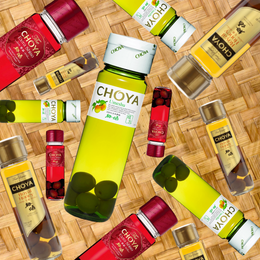
Dassai is a leading figure in the world of Sakes today - and yet, it wasn't too long ago that the Yamaguchi Prefecture brewery was shrouded in relative obscurity and was in search of a turnaround.
In the brewery's toughest moments, its Sake brew master (known as a toji) left, and yet this became the very spark that would turn Dassai into the success it is today.
Here are 8 things you should know about Dassai.

"Dassai" comes from the name "Otter Festival"
Dassai is the flagship brand of Sake from brewery, Asahi Shuzo, that is based in the Yamaguchi Prefecture. The Prefecture is known for its otters that would frolick in the nearby rivers and would often lay out the fish they caught as if to showcase them in a festival.
The name "Dassai" was even used as a pen name by a popular Japanese poet, Masaoka Shiki, as he would often scatter his reading materials around his room much like the otters would with their caught fish. Nonetheless Masaoka was said to have revolutionised Japanese literature with his haikus during the Meiji Era, and hence Asahi Shuzo would later latch on to this name as they had wanted to embody that same pioneering spirit.
The Toji (or Sake Brew Master) is revered as a critical part of any Sake brewery - Dassai did away with that.
The Toji's responsibility is to serve as the conductor of the orchestra that is the Sake brewery. With years of training under a guild, the Toji knows the steps to making quality Sake well, and is particularly skilled with embodying a regional style of Sake. The Toji pays particular attention to employing the use of koji (inoculated rice) that helps rice turn into fermentable sugars.
Yet, as Dassai's brewery, Asahi Shuzo, faced the very real possibility of shuttering, its Toji left. With no options left, the brewery's head, Hiroshi Sakurai, decided to forgo the use of a Toji, and instead turned to modern technology to mirror and automate some of the key the actions and activities taken and monitored by the Toji. This allowed Asahi Shuzo to break free from tradition and reinvent itself.

Dassai was not actually the brewery's first Sake.
Asahi Shuzo was founded in 1948 and had been retailing rather average sakes for decades before third generation Hiroshi Sakurai had came to the family business.
As the family business had taken a downturn, Sakurai was convinced that something had to be changed if the family business was to survive - he would cull the average sakes and focus entirely on the premium sake category with only junmai daiginjo's made using Yamada-nishiki rice. He gave the family's premium sake the name "Dassai" and for awhile things begin to look brighter.

Dassai pioneered the ultra low rice polishing ratio trend that Sake makers aspire to today.
In order to create a premium Sake, Sakurai began to conceptualise an ultra low 23% polishing ratio Sake - only 23% of the original rice grain would be left after polishing. This would require 168 hours, or 7 straight days of polishing the rice grains, in order to achieve. By leaving the most concentrated core of the rice grain (called the heart of the rice, or shinpaku), the outer bran which is more uneven and umami in taste is removed, leaving only a pure starchy center that is used for brewing a pristine Sake.
This is was incredibly challenging technically as such a small core meant a more delicate remaining grain that could potentially crumble. Yet, this is what allows Dassai to achieve its signature translucent quality, known as toumeikan.
The Dassai 23 almost did not happen.
Whilst conceptualising the premium Sake, Sakurai had initially started out with the idea of having the rice grains polished to 25% rice polishing ratio. However, whilst the rice polishing was underway, Sakurai got word that a competitor had achieved a 24% rice polishing ratio. Refusing to be bested, Sakurai would request his staff bring the rice polishing ratio down to 23%, requiring an additional 24 hours of milling.
This would allow Dassai to take the crown of "Japan's most polished Sake".

Dassai's founder was quick to bring the Sake to internationally metropolitan cities which is why you'll find the Sake in Michelin-starred restaurants.
As Japan in the 1990's was facing a decline in Sake consumption, Sakurai had felt that unlike other Sake brewers, he should not simply focus on the domestic market, which favoured foreign products. Thus he turned his attention to major cities such as New York, Paris and Milan.
He would bring his son along for his personalised sales pitches to Michelin-starred chefs, and would eventually find success with famous French chef Joel Robuchon, paving the way for Dassai to be served in some of the world's most lauded restaurants.

The Dassai 23 Is The Real Star Product
Today Dassai is synonymous with Japan's sake and is often held in high regard by many and whose quality is often times unquestionable. In 2021, Dassai alone accounted for 17% of total sake exports out of Japan; a staggering number.
Much of Dassai's success has been centered on its landmark Dassai 23 expression, where it was the first brewery to achieve an unprecedented rice polishing ratio of 23% (meaning only 23% of the original rice grain is left, leaving a highly refined shinpaku for brewing). Its also furnished its premium branding but focusing purely on higher end classifications of producing only junmai daiginjo sake (the highest grade of sake) using only yamadanishiki rice (known as the King of Sake Rice) with nothing else added besides rice, water, yeast and koji.

Dassai Is Coming To New York
Dassai's success and desire to penetrate markets abroad has led to the brewery spending more than US$7 million to set up a brewery in New York, that it hopes will allow for wider distribution, consumption and appreciation in the massive market of the US.
Kanpai!

@111hotpot




